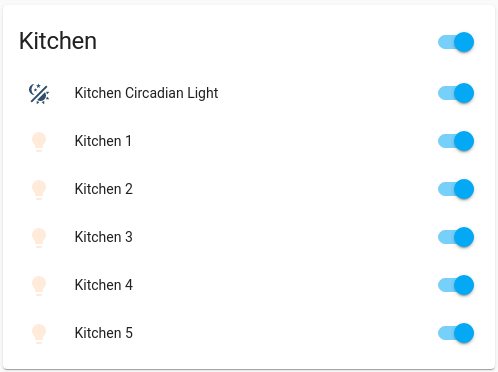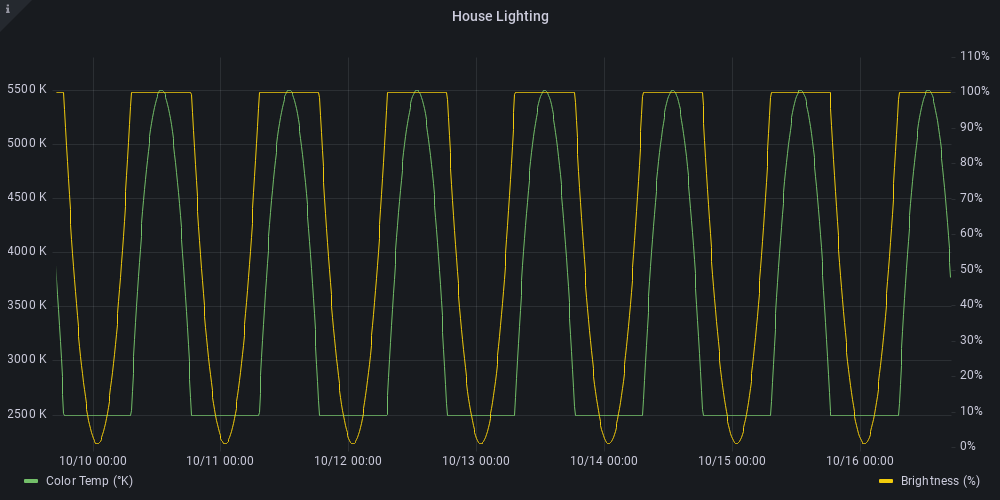Artificial lighting is omnipresent in contemporary society with
disruptive consequences for human sleep – Sarah L Chellappa, https://doi.org/10.1093/sleep/zsaa214 Light messes with my sleep, mood, and alertness. My house lights should auto-adjust themselves—like f.lux or redshift on my laptop: I was worried that getting this to work for my whole house meant
endless fiddling with “smart” devices. But Home Assistant
papered over the vendor and hardware woes and made setup simple. I had the following goals for this project: The effects have been subtle but noticeable. During the day, I’m sharp, and at night I’m ready to sleep. In the evenings, after the sun sets, the lights dim, and it gets
harder to read and work on projects—that’s a feature.
It’s a signal that it’s time for bed. The most significant benefit I’ve noticed is that I can get
back to sleep after getting up in the middle of the night—now
that I’m no longer blinded by harsh overhead light in the bathroom. Home Assistant made this possible. The Circadian
lighting component (available via Home
Assistant Community Store (HACS)) computes solar noon based on my
location and auto-adjusts the brightness of my lights and the color
temperature based on the time of day. I use Zigbee2MQTT to
capture events from my switches and send them to Home Assistant over MQTT—I found
this easier than adding a Zigbee gateway to Home Assistant directly. I have automation
that allows me to override circadian lighting when I need maximum
brightness or when I want the nightlight. Lights: Buttons: Other hardware: House lighting is never done. I have ideas for my lights that I’m
still pondering. It took me two years as a manager to reach the “leadership is lonely”
phase. – Will Larson, An Elegant Puzzle When you jump from tech lead to manager: things change. Your deep understanding of the system evaporates and becomes shallow.
You’ll stop writing all the critical code. Your focus will shift. But for me the weirdest change was everyone treating me like a
manager all the time. The transition from tech lead to manager is awkward. You know the work of the team as well as anyone. But moving to management grants you special powers—all new and
unfamiliar: These are superpowers. You should relish these opportunities—you’re
empowered to contribute to the team like no one else can. But your new powers may leave your team uneasy. And if you fail to
reckon with this new power imbalance, you risk alienating people. The second you became their manager you forfeited the right to joke
around in any capacity about their employment at the company. You can hire, and you can fire. This Sword of Damocles now dangles
over your relationships as a manager. “Oh, what’s the worst that can happen? We all get fired?” has ceased
to be light-hearted banter. Folks might laugh, but it leaves lingering doubt. And doubts chip
away at the trust teams need to do their job. It may seem trivial, but asking your question before getting that
initial salutatory reply also allows for asynchronous communication. – no hello Now that you’re a manager, your contentless
pings have transformed from annoying to panic-inducing. Sure, you should avoid saying nothing but “hi!” to someone in a
direct message. But you should never, ever say something like, “Do you have a minute
to jump on a call?” without context. “Do you have a minute to talk?” from your boss, out of nowhere,
immediately sets people’s minds racing. Is this about my project? Something with the budget? A policy change?
A change to my benefits? Am I being fired? Your manager powers will wreak havoc on people who tend to
catastrophize. People expect you to be the decider. Even for small stuff. Folks may even be unaware they have this expectation. But it applies to everything from team vision to where we’re eating
dinner at the offsite. You can and should delegate decisions, but you
can’t abdicate. Clear is kind. Unclear is unkind. – Brené Brown, Dare
to Lead When you leap from tech lead to manager, you have to learn about
people. And what people need most from you is clarity. So instead of striving to be liked, or striving to be funny: you
should strive to be clear.

The goals of my house lighting
The Results

Home Assistant setup


The hardware setup

TODO: finish lighting
Managers are leaders with awkward power 😬
Never make folks worry about their livelihood 😟
Contentless pings from managers are scary 😱
You’re the decider ☑️
Clarity is key 🔑
Posted
Posted